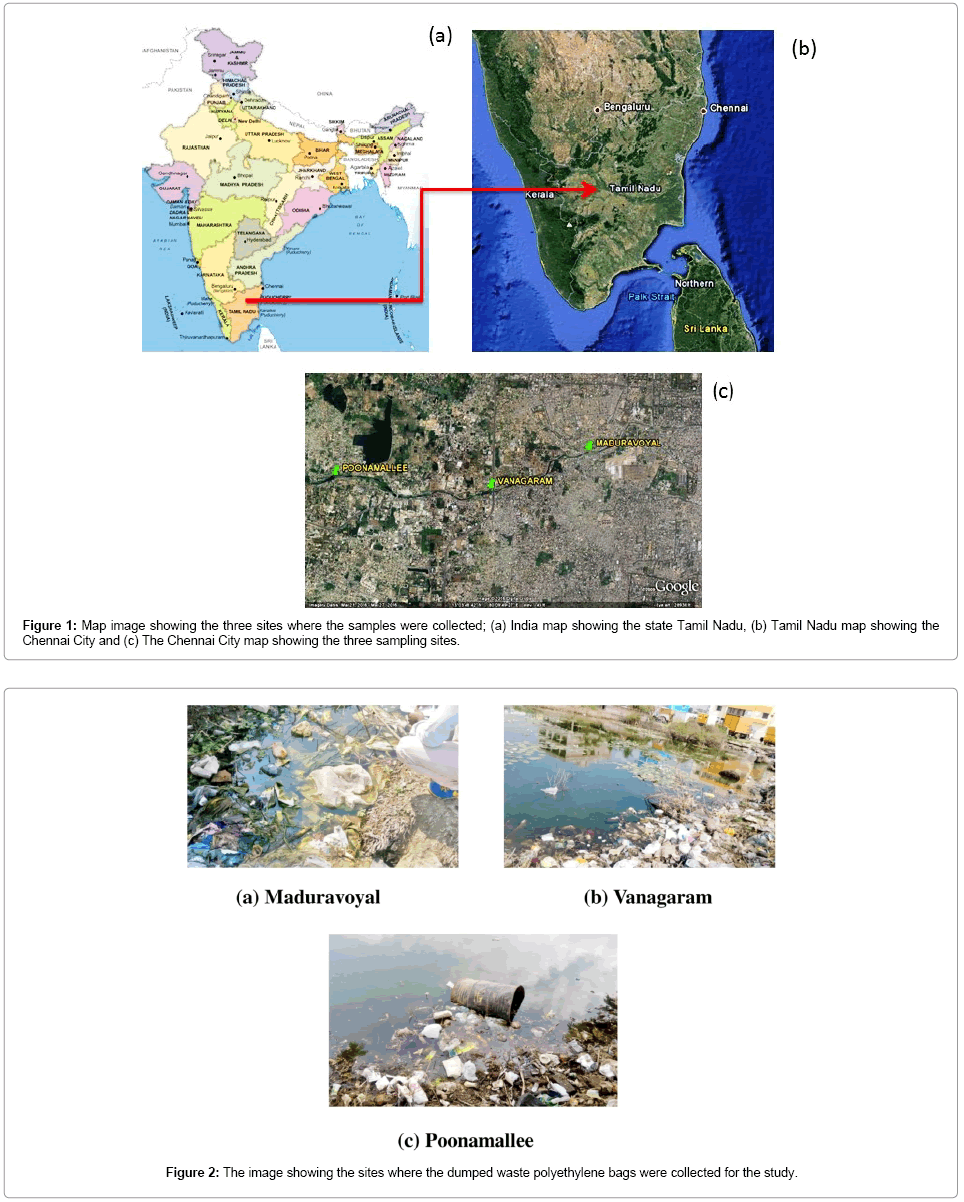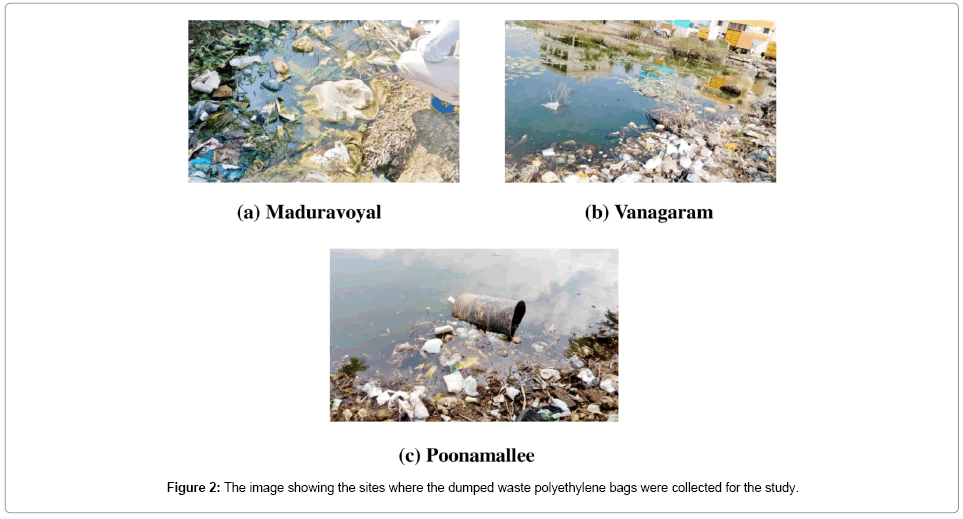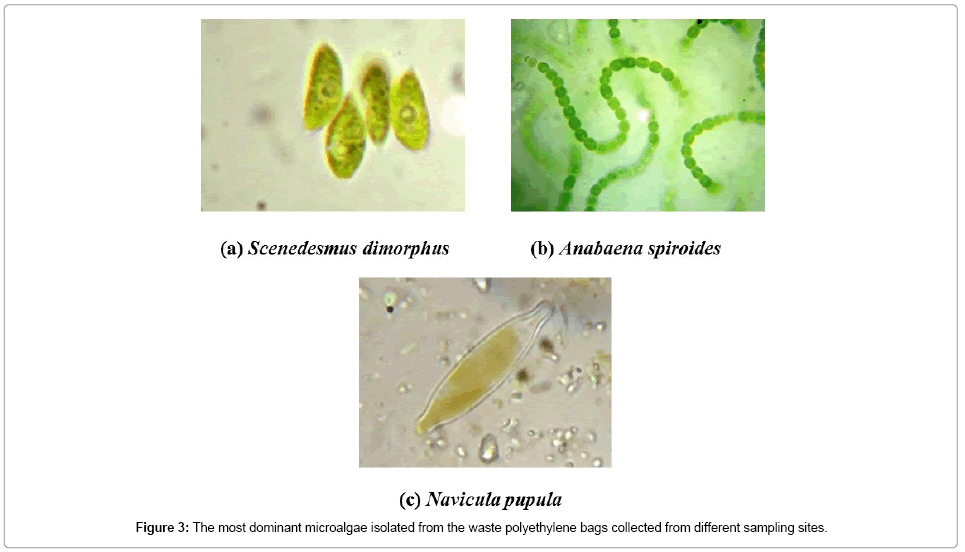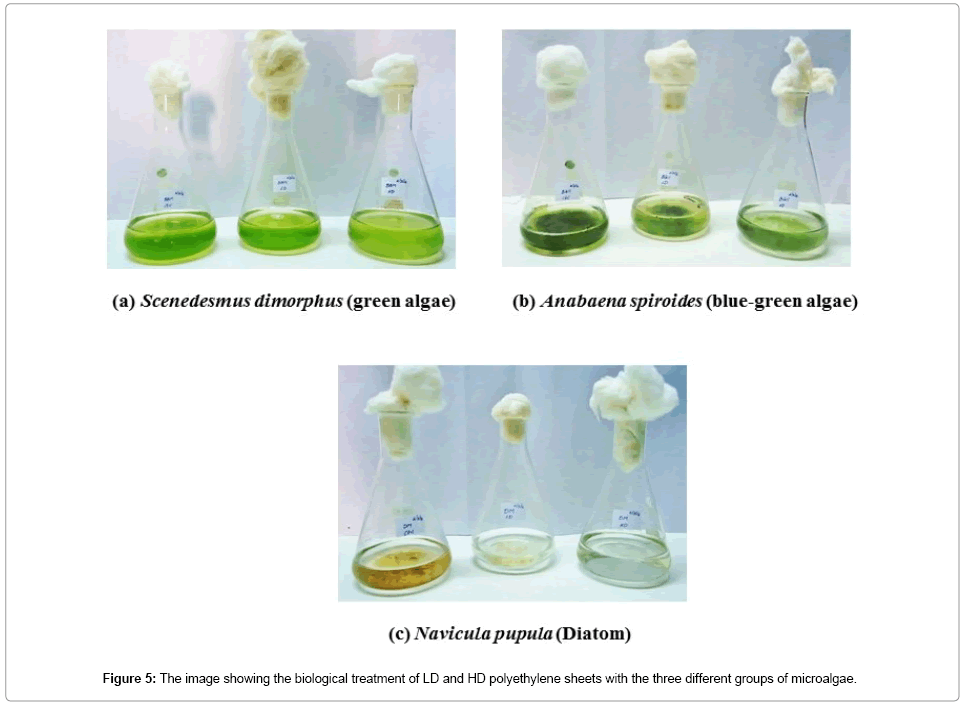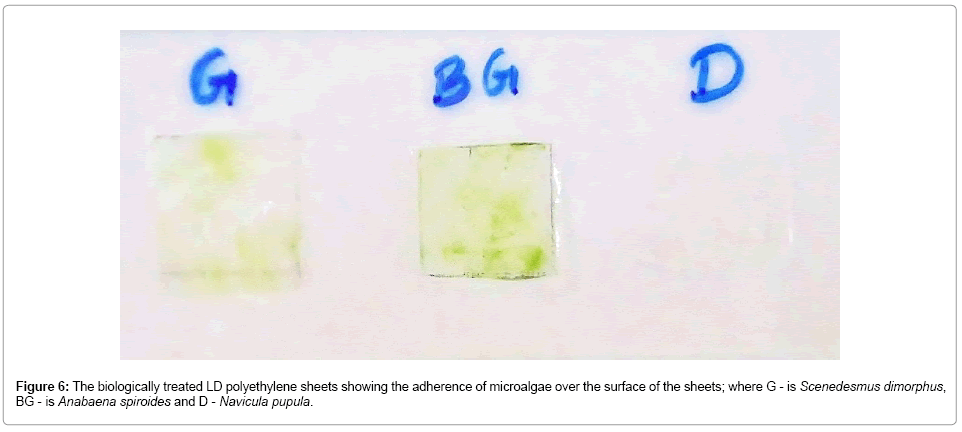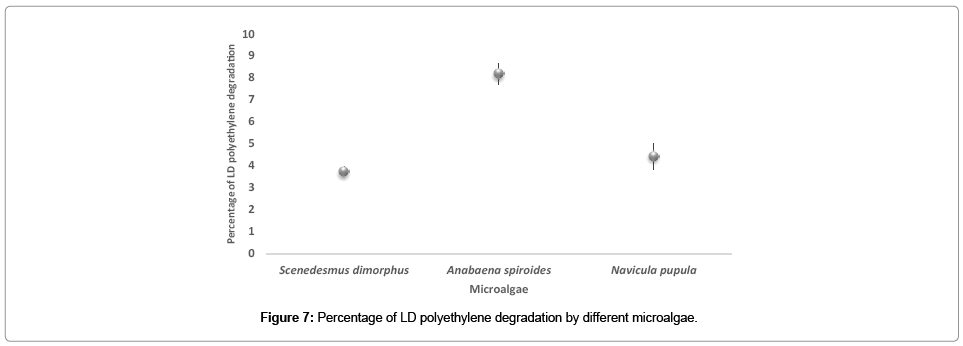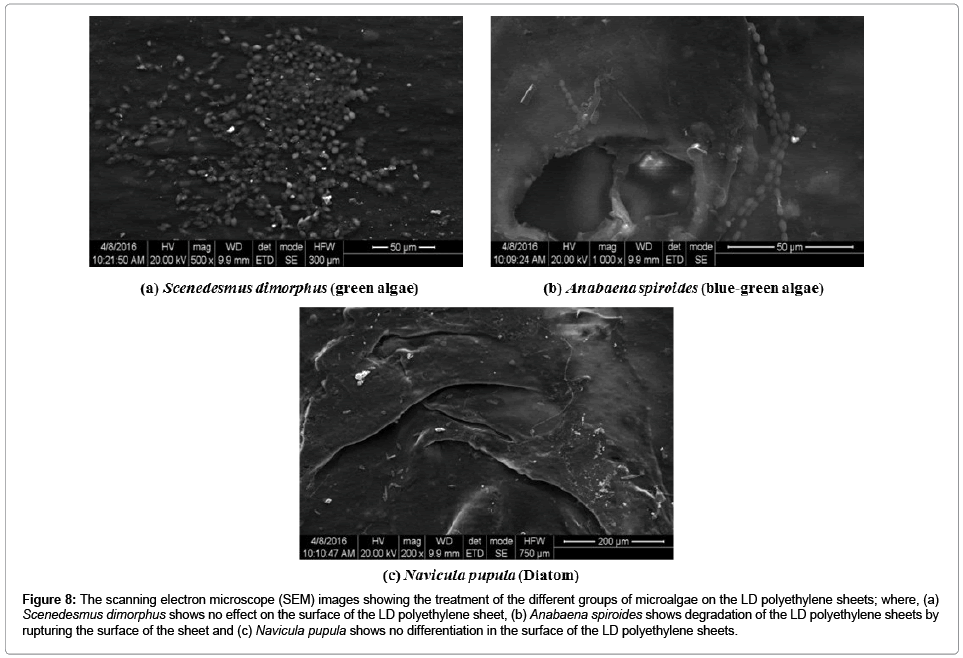Research Article Open Access
Biodegradation of Polyethylene by Green Photosynthetic Microalgae
Ramachandran Vimal Kumar1, Gopal Rajesh Kanna2 and Sanniyasi Elumalai1*
1Department of Biotechnology, University of Madras, Guindy Campus, Chennai, Tamil Nadu, India
2Department of Plant Biology and Plant Biotechnology, Presidency College (Autonomous), Chennai, Tamil Nadu, India
- *Corresponding Author:
- Sanniyasi Elumalai
Department of Biotechnology, University of Madras
Guindy Campus, Chennai, Tamil Nadu, India
Tel: +919940053996
E-mail: ananandal@gmail.com
Received Date: December 13, 2016; Accepted Date: January 09, 2017; Published Date: January 11, 2017
Citation: Kumar RV, Kanna GR, Elumalai S (2017) Biodegradation of Polyethylene by Green Photosynthetic Microalgae. J Bioremediat Biodegrad 8:381. doi: 10.4172/2155-6199.1000381
Copyright: © 2017 Kumar RV, et al. This is an open-a ccess article distributed under the terms of the Creative Commons Attribution License, which permits unrestricted use, distribution, and reproduction in any medium, provided the original author and source are credited.
Visit for more related articles at Journal of Bioremediation & Biodegradation
Abstract
Conventional methods of polyethylene degradation including incineration, landfill and chemical treatment are lethal to the neighboring environment by causing hazardous effects on living organisms. A better solution for the complete degradation of polyethylene has not yet been formulated. However, to solve this global issue biological mode of polyethylene degradation may be evaluated and developed in the upcoming future. In this research investigation, microalgae like green algae, blue-green algae and diatoms were isolated from the domestic polyethylene bags dumped in the suburban water bodies and studied for its potency on deterioration of polyethylene. The dumped waste polyethylene bags were collected from three different sites of (Maduravoyal, Vanagaram and Poonamallee) Chennai, Tamil Nadu, India. Colonized mat of microalgae were isolated from the polyethylene sheets and the most dominant three different groups of microalgae were selected for the biological treatment of LD (low density) and HD (high density) polyethylene sheets. The most dominant microalgae were Scenedesmus dimorphus (Green microalga), Anabaena spiroides (blue-green alga) and Navicula pupula (Diatom). The T. S. (Transverse section) of polyethylene sheet has shown the proliferation of microalgae in both outer and inner sides of the polyethylene sheet and the erosion cum degradation can be seen obviously. The biological treatment of the selected microalgae on the LD and HD polyethylene sheets with their respective culture media resulted that the microalgae proliferated more on the LD than the HD polyethylene sheets followed by the highest percentage of degradation was obtained from Anabaena spiroides treatment (8.18%). Similarly, among the three microalgal groups treated over the LD polyethylene sheets. The scanning electron microscopical study reveals that the degradation was obviously evident in the treatment of LD polyethylene sheets using the microalga Anabaena spiroides (filamentous blue-green alga) and was found to grow feasibly rather than the other microalgae.
Keywords
Polyethylene; Biodegradation; Microalgae; SEM
Introduction
Plastics (Polyethylene) are the synthetic organic polymers which are commonly produced from high density polyethylene, one of the petroleum derived product. The plastic carrier bags are routinely used for carrying groceries, clothing and other merchandises [1]. It was from late 1970s that the plastic carrier bags have become a common element in our day to day life in this globalized world. The increasing use of plastics, particularly packaging has become a significant source for environmental pollution and creating problems in solid waste management as well as lethal to wild life and human being due to its non-degradability in nature.
It is estimated that around 500 billion plastic bags are being used every year worldwide. This widespread utilization is attributed to their cheapness and convenience to use. The vast majority of these bags are discarded as wastes usually after a single use. It has been revealed that after their entry into environment, plastic bags can persist up to 1000 years without being decomposed. Accumulation of plastic bag wastes causes environmental pollution that can be manifested in number of ways. Biological degradation is an attractive, recent and alternative approach to plastic waste management, which is generally a cheaper process, potentially much more efficient and does not produce any hazardous compounds, as in the case of conventional degradation [2]. Additionally, the microbial degradation of polyethylene sheets may yield commercial end products from their biomass [3].
There are only three degradative methods including landfill, incineration and recycling are being followed on large scale basis. In the case of direct incineration, the plastics emit poisonous gases such as dioxins, carbon mono-oxide, NOx, SOx and heavy metals [4] in to the atmospheric air. However, as a result the remnants after these treatments causing severe damages to the environment. Landfill and incineration both lead to the release of dangerous gases into the environment, and landfill also has an additional drawback in the requirement of large portions of land space. Recycling of plastics addresses the environmental concerns of landfill and incineration, but the process is relatively inefficient and diminishes quality of the polymer yielded. The process is also less cost-effective, and subsequently, there is less incentive for investment in recycling facilities.
Public people usually put waste plastics in landfills or burn them, but both these practices cause very serious adverse effects to the ecosystem. Incineration of plastics usually produces some hazardous greenhouse gases like furans and dioxins, which play an important role in ozone layer depletion. Dioxins can cause serious problems in the human endocrine hormone activity, thus becoming a major concern for the human health [5,6] and can cause very serious soil pollution. Therefore, under such circumstances degradation of plastic by microbes is one of the eco-friendly and innovative methods in the near future [7]. Biodegradation is an effective option for eco-friendly degradation of plastic waste. No protocol has yet been developed to feasibly degrade polyethylene by biodegradation on a commercial scale. However, substantial research is still being conducted in the field of biodegradation of polymers, and given the vast metabolic potential of microorganisms [8]. Biodegradation involves a biological agent utilizing the organic polymer as a substrate for their growth and energy, so that the end product of complete biodegradation will be microbial biomass.
The major objective of the present research investigation is to treat and degrade the polyethylene sheets biologically using photosynthetic microalgae isolated from the dumped waste polyethylene bags from the domestic waste water in Chennai City, Tamil Nadu, India.
Materials and Methods
Collection of samples
The dumped waste polyethylene bags colonized by green photosynthetic microalgae and water samples were collected from the fresh water bodies including ponds, pools and ditches from three different regions; Vanagaram, Poonamallee and Maduravoyal, around Chennai, Tamil Nadu, India during the month of January 2016. These are the areas where large number of industries are located along with huge human commercial activities. The collected polyethylene bags were brought to the laboratory within 24 hours, named and stored with respect to their sites. All the collected polyethylene bags with a mass of microalgal mat on their surface were wiped using a sterile blade; dispersed in distilled water and stored in vials. All the vials were stored in refrigerator in order to keep the microalgae in live condition. All the collected water samples were centrifuged separately at 8000 rpm for 5 min. to concentrate the microalgae. The microalgae are concentrated in the pellet were separated from the supernatant; conserved in vials and stored in refrigerator.
Isolation and identification of microalgae
The microalgal samples conserved from both polyethylene bags and water samples were subjected to serial dilution using sterile distilled water. All the serials from 10-1 to 10-10 were further used as inoculums (1 ml) in three different solidified media including BBM (for green microalgae) [9], BG11 (for blue-green algae) [10] and DM (Diatom medium) [11] based on spread plate technique. All the inoculated Petri dishes were incubated under 12 hrs of illumination for a week at room temperature (27 ± 2°C). The grown microalgae as colonies over the surface of the solidified medium were marked and observed under compound microscope (Olympus CH20i) and photographed. Pure microalgal cultures were isolated by further streak plate method with their solidified media respectively. All the three different microalgae were morphologically identified based on the manual ‘Microalgae Identification for Aquaculture’ [12].
Transverse section of collected polyethylene bags
The green microalgae grown on the surface of polyethylene bags were allowed to take transverse sections with the use of Microtome. Thin and fine sections were selected and optically observed under compound microscope and photographed.
Biological treatment of polyethylene sheets
Both low density (LD) and high density (HD) polyethylene sheets were chosen for the biological treatment and are then trimmed to 1 sq. cm. The LD and HD polyethylene sheets were used to treat biologically and separately with the three different microalgae culture media (BBM, BG11 and DM) using the selected microalgae based on their domination over the occurrence of other microalgae, which are Scenedesmus dimorphus (green microalga), Anabaena spiroides (bluegreen alga) and Navicula pupula (diatom) respectively. About 200 ml of culture media were prepared in 500 ml Erlenmeyer flasks, with three conical flasks for each culture media named as control, LD and HD respectively. Two 1 sq. cm. polythene sheets were incorporated in all the culture media except the control and all the culture media were autoclaved at 121°C, 15 psi for 15 min. Then the selected green alga, blue-green alga and diatom were inoculated (1%) to their respective culture media and incubated under light illumination (12:12 h dark and night) for a month at room temperature (27 ± 2°C). The degradation percentage of polyethylene sheets after biological treatment were determined gravimetrically and recorded. The average weight of 1 sq cm LD Polyethylene sheets were 6.07 mg and 8.945 mg for HD polyethylene sheets before treatment. After the biological treatment the algal mass were gently wiped off and dried and then weighed gravimetrically to analyze the percentage of degradation.
Scanning electron microscopy (SEM) analysis
The microalgae treated polythene sheets were subjected to analyze qualitatively using scanning electron microscopy (SEM). The samples were allowed to ionize using the ion sputter on a metal stub for 20 min. After gold coating, the samples were kept under vacuum to view microscopically from 50 X to 15000 X magnification using the scanning electron microscope (SEM) (FEI Quanta FEG200 – HRSEM) and photographed.
Results and Discussion
Field survey and sample collection
A total of 20 dumped waste polyethylene bags with green mat of photosynthetic microalgae were collected from three different sites Maduravoyal (8 samples), Vanagaram (5 samples) and Poonamallee (Seven samples) (Figures 1 and 2). Along with the polyethylene samples water samples were also collected using sterile vials. Screening of microorganisms which can degrade polymers, or produce enzymes or enzyme systems that degrade polymers may prove as eco-friendly and cost effective in the upcoming century. Hence, universally uniform standards are also necessary for the assessment of their degradative ability [13]. From this present investigation, about 20 dumped polythene bags were collected for screening of microbes naturally involved in biodegradation of plastics.
Isolation and identification of microaglae
The three different groups of microalgae including green algae, bluegreen algae and diatom were isolated and identified. Among the green microalgae isolated from the collected polythene bags and domestic waste water, Scenedesmus dimorphus (Table 1) was found dominant. The same way, Anabaena spiroides (Table 2) was blatantly dominating among the blue-green algae when compared with all the three sites. Similarly, the diatom Navicula pupula (Table 3) was found dominant among the other diatoms isolated. Most of the dominant microbes of the biofilm were algae and about fifteen different algal colonies were found to proliferate on the surface of polythene seen under scanning electron microscope [14]. Three different groups of photosynthetic microalgae were evident growing on the surface of polythene bags. In which, Scenedesmus dimorphus (green alga), Anabaena spiroides (blue-green alga) and Navicula pupula (diatom) are most dominant microalgae as a result of this present study (Figure 3).
| Kingdom | Protista |
| Phylum | Chlorophyta |
| Class | Chlorophyceae |
| Order | Sphaeropleales |
| Family | Scenedesmaceae |
| Genus | Scenedesmus |
| Species | dimorphus |
Table 1: Systematic position of the green microalga Scenedesmus dimorphus.
| Kingdom | Bacteria |
| Phylum | Cyanobacteria |
| Class | Myxophyceae |
| Order | Nostocales |
| Family | Nostocaceae |
| Genus | Anabaena |
| Species | spiroides |
Table 2: Systematic position of the blue-green alga Anabaena spiroides.
| Kingdom | Chromalveolata |
| Phylum | Heterokontophyta |
| Class | Bacillariophyceae |
| Order | Naviculales |
| Family | Naviculaceae |
| Genus | Navicula |
| Species | pupula |
Table 3: Systematic position of the diatom Navicula pupula.
Transverse section (T. S.) of collected polyethylene sheets
The T. S. of the collected polyethylene sheets has shown colonization of all the three different groups of microalgae; green microalgae (Chlorophyceae), blue-green algae (Cyanophyceae) and diatom (Bacillariophyceae). The T. S. of the polyethylene sheets not only shown the colonization of microalgae, but also breakdown or degradation of the surface of the polyethylene sheets which can be seen obviously in the Figure 4. There are several methods reported in the biodegradation, some of the methods are fouling, degradation of leaching components, corrosion, hydrolysis and penetration and pigment coloration by diffusing into the polymers. Fouling is referred to as the change of surface properties and contamination of the surrounding media by biofilm formation on polymer surfaces. The second method is the degradation of leaching component such as additives and monomers. But, the penetration of polymers was not obtained. The components may leach out, providing a food source. This form of degradation results in embrittlement and loss of stability.
The third method is corrosion, where corrosion or erosion of the surface of the polymers was clearly seen and the fourth method is hydrolysis and penetration. Because biofilms consist of over 80% water they provide an ideal electrolyte that increases surface conductivity and also swelling. The fifth method is not the exact degradation of polymers, but rather some microorganisms produce pigments and tend to diffuse into the polymers giving a strange coloration [15]. The occurrence of three groups of microalgae (green algae, blue-green algae and diatom) was found evident while observing the microscopic images of transverse section of the polythene sheets from the present study. From which, all the above mentioned five methods of biodegradation was observed.
Biological treatment of polyethylene sheets
The three selected microalgae Scenedesmus dimorphus, Anabaena spiroides and Navicula pupula were found to grow feasibly in the control flasks of all the three culture media respectively when compared with the LD and HD polyethylene sheet treatment flasks. But when compared between those LD and HD polyethylene sheet treatment, all the three microalgae shows high growth which was favorable and obviously seen in LD polyethylene sheet treatment (Figure 5). Among the three different microalgae used for the biological treatment, the blue-green alga Anabaena spiroides had shown high mass colonization over the surface of the LD polyethylene sheets than the other two microalgae (Figure 6). Microbes, especially microalgae with mucilaginous secretion of extracellular polymeric substances (exopolysaccharides) (EPS) (Biofilm) are the primary colonizers of building materials, walls, rocks, etc. and play a significant role in their bio deterioration [16]. The Biofilms (BFs) are accepted to play an important role in biodegradation and their activity has been investigated globally [17].
Biofilms represent one of the oldest forms of community based life on this planet. Microbes tend to attach themselves and colonize the surface in the form of biofilms. Some features are displayed in biofilms that cannot be found in microorganisms in suspended forms. In biofilms, the cells are embedded in a polymeric matrix of their own origin, mainly consisting of polysaccharides and proteins. From our current study, the biological treatment of polythene sheets using the three groups of microalgae shown that the microalgae were found colonized more on the low density (LD) polythene sheets when compared to the high density (HD) polythene sheets. And in comparison between the treated microalgae, the blue-green alga Anabaena spiroides was colonized more efficiently on the surface of the LD polythene sheet. Therefore, this may due to the fact that the filamentous blue-green algae can form mucilaginous biofilms over the substrate it grows. The biological degradation of LD polyethylene sheets were obviously seen from all the three different microalgal treatment. The green alga Scenedesmus dimorphus shows the average percentage of degradation by 3.74% (+/-0.26) and blue-green alga (Cyanobacterium) Anabaena spiroides showing 8.18% with +/-0.66 followed by Diatom Navicula pupula contributing about 4.44% (+/-0.82) (Figure 7). From the above results, it has been revealed that the blue-green alga holds quantitatively the highest percentage of degradation of LD polyethylene sheets.
Scanning electron microscopic (SEM) analysis
The cells of the green microalga Scenedesmus dimorphus found adhered to the surface of the LD polythene sheet, but no changes were seen on the surface of the LD polythene sheet which can be seen clearly in Figure 8. Whereas, the blue-green alga Anabaena spiroides not only found colonized to the LD polythene sheet and has ruptured to form a minute hole in the surface of the LD polythene sheet. The diatom Navicula pupula had shown that the surface of the LD polythene sheets was partially eroded. The microorganisms isolated from the forest soil and automobile wash-out sludge found degrading the plastic after 45 days of incubation by forming cavities on the surface of the plastic by SEM analysis [18].
Figure 8: The scanning electron microscope (SEM) images showing the treatment of the different groups of microalgae on the LD polyethylene sheets; where, (a) Scenedesmus dimorphus shows no effect on the surface of the LD polyethylene sheet, (b) Anabaena spiroides shows degradation of the LD polyethylene sheets by rupturing the surface of the sheet and (c) Navicula pupula shows no differentiation in the surface of the LD polyethylene sheets.
The Chaetophorales algae, diatoms and blue-green algae (phytoplankton) produce extracellular polymeric mucilaginous substance which adheres to any type of the substratum [19]. The extracellular polysaccharides of phytoplankton have high content of sugars like rhamnose, xylose and mannose [20] which helps in foaming and flocculation. These photosynthetic microalgal species along with other aquatic microbes are the primary colonizers that form biofilm and serve as cue for other larger organisms to colonize on the surface. Colonization of larger microorganisms is called fouling, which affects the strength and performance of submerged objects [21]. The Scanning electron microscopic images of the microalgae revealed profuse cracks on polythene on the adherence of algal species [14]. The similar kind of result was obtained from the present study, that among the three different microalgae treated on the LD polythene sheets; Anabaena spiroides (blue-green algae) alone forms a cavity on the surface of the polythene sheets and which is evident from the SEM analysis. The diatom Navicula pupula had shown some erosion on the surface of the LD polythene sheets.
Conclusion
The photosynthetic microalgae are the most dominant microbes found in the waste water ecosystems. Thus, the microalgal colonies are found dominant on the surface of the dumped polyethylene bags due to the availability of nutrients, water and sun light. Therefore, from the present study it has been proved that the microalgae are efficient in colonizing over the surface of the polythene sheets and also biodegradation was clearly evident. Therefore, it has been concluded that among different groups of microalgae; blue-green algae is the filamentous form effective in the biodegradation of polythene sheet.
Conflict of Interest
The authors have no conflict of interest.
References
- Accinelli C, Saccà ML, Mencarelli M, Vicari A (2012)Deterioration of bioplastic carrier bags in the environment and assessment of a new recycling alternative. Chemosphere 89: 136-143.
- Michaud L, Di Marco G, Bruni V, Giudice AL (2007) Biodegradative potential and characterization of psychrotolerant polychlorinated biphenyl-degrading marine bacteria isolated from a coastal station in the Terra Nova Bay (Ross Sea, Antarctica). Mar Pollut Bull 54: 1754-1761.
- Iranzo M, Sainz-Pardo I, Boluda R, Sanchez J, Mormeneo S (2001) The use of microorgansims in environmental remediation. Ann Microbiol 51: 135-143.
- Sharma M, DubeyA,PareekA (2014) Algal flora on degrading polythene waste. CIB Tech Journal of Microbiology 3: 43-47.
- No Plastics in the Environment (NoPE) Imports Versus Surplus: a glut of plastics in India today, January 10, 2002. BharatiChaturvedi, Director, Chintan Environmental Organization in New Delhi.
- Pilz H, Brandt B, Fehringer R (2010) The impact of plastics on life cycle energy consumption and greenhouse gas emissions in Europe.Summary Report, Denkstatt GmbH, Vienna, Austria.
- Ghosh SK, Pal S, Ray S (2013) Study of microbes having potentiality for biodegradation of plastics. Environ Sci Pollut Res 20: 4339-4355.
- Webb HK, Arnott J, Crawford RJ, Ivanova EP (2013) Plastic Degradation and Its Environmental Implications with Special Reference to Poly (ethylene terephthalate). Polymers 5: 1-18.
- Bischoff HW, Bold HC (1963) Phycological studies. IV. Some soil algae from Enchanted Rock and related algal species. University of Texas Publications 6318: 1-95.
- Stainer RY, Kunisawa R, Mandel M, Cohen-Bazire G (1971) Purification and properties of unicellular blue-green algae (order Chroococcales). Bacteriol Rev 35: 171-205.
- Beakes GW, Canter HM,Jaworski GHM (1988) Zoospore ultrastructure of Zygorhizidiumaffluens and Z. planktonicum, two chytrids parasitizing the diatom Asterionellaformosa. Can J Bot 66: 1054-1067.
- Rosen BH (1990) Microalgae identification for aquaculture.Florida Aqua Farms, Dade City, Florida, USA.
- Shah AA, Hasan F, Hameed A, Ahmed S (2008) Biological degradation of plastics: A comprehensive review. Biotechnology Advances 26: 246-265.
- Suseela ARM (2007) Algal biofilms on polythene and its possible degradation. Current Science 92: 285-287.
- Flemming HC (1998) Relevance of biofilms for the biodeterioration of surfaces of polymeric materials. Polymer Degradation and Stability 59: 309-315.
- Treub M (1888) Notice on the new flora of Krakatau. Ann Jardin Bot Buitengorg7: 213-223.
- Lerchner J, Wolf A, Buchholz F, Mertens F, Neu TR, et al. (2008) Miniaturized calorimetry-A new method for real-time biofilm activity analysis. Journal of Microbiological Methods 74: 74-81.
- Dey U, Mondal NK, Das K, Dutta S (2012) An approach to polymer degradation through microbes. IOSR Journal of Pharmacy 2: 385-388.
- Fritsch FE (1965) The Structure and Reproduction of the Algae. Cambridge UniversityPress 1:937.
- Hoagland KD, Rosowski JR, Gretz MR, Roemer SC (1993) Diatom extracellular polymeric substances: function, fine structure, chemistry and physiology. JPhycol 29: 537-566.
- Ford T, Mitchell R (1990) The ecology of microbial corrosion. AdvMicrobEcol 11: 231-261.
Relevant Topics
- Anaerobic Biodegradation
- Biodegradable Balloons
- Biodegradable Confetti
- Biodegradable Diapers
- Biodegradable Plastics
- Biodegradable Sunscreen
- Biodegradation
- Bioremediation Bacteria
- Bioremediation Oil Spills
- Bioremediation Plants
- Bioremediation Products
- Ex Situ Bioremediation
- Heavy Metal Bioremediation
- In Situ Bioremediation
- Mycoremediation
- Non Biodegradable
- Phytoremediation
- Sewage Water Treatment
- Soil Bioremediation
- Types of Upwelling
- Waste Degredation
- Xenobiotics
Recommended Journals
Article Tools
Article Usage
- Total views: 16382
- [From(publication date):
January-2017 - Apr 05, 2025] - Breakdown by view type
- HTML page views : 13810
- PDF downloads : 2572

